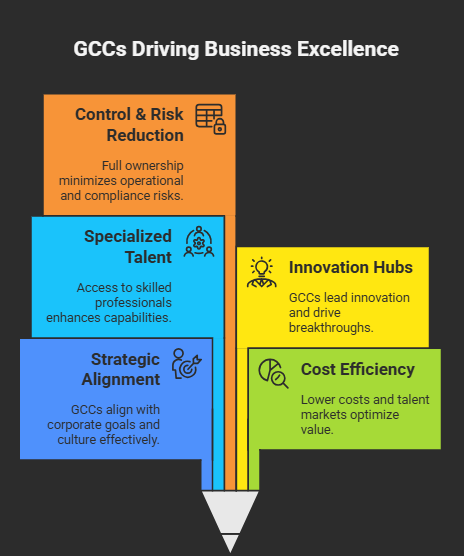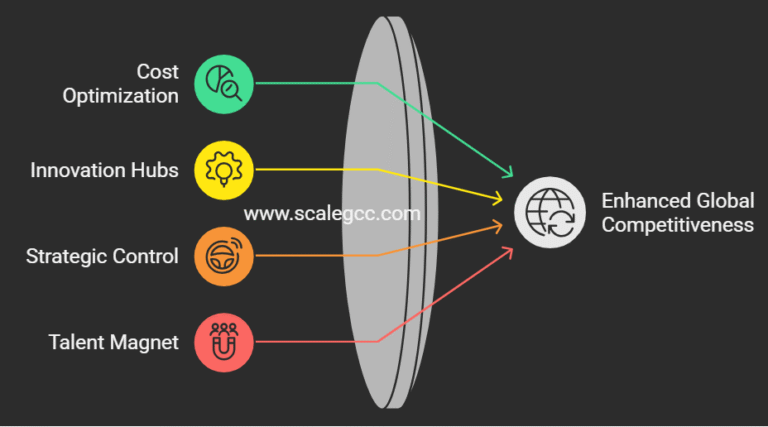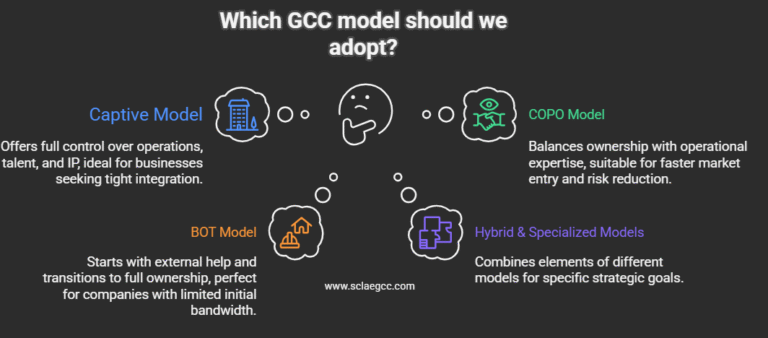Global Capability Centers (GCCs)
Unlocking Global Potential: What is a GCC?
What is a Global Capability Center (GCC)?
Think of a Global Capability Center (GCC) as much more than a back-office extension. It’s a strategic outpost of a multinational company, set up not just to reduce costs, but to tap into global talent, drive efficiency, and build specialized capabilities under full ownership.
At its core, a GCC is an integrated global arm of the enterprise situated offshore or nearshore, designed to centralize operations, enhance agility, and spark innovation. What started as cost-focused service centers have rapidly evolved into engines of digital transformation and strategic value. Today, many GCCs are trusted to lead critical functions, foster innovation, and act as embedded Centers of Excellence within their parent organizations.
What truly sets a GCC apart from traditional outsourcing? It’s the direct control. The company owns the operation, retains its talent, protects its IP, and aligns every process to its culture and goals. This model enables businesses to build deeply aligned, high-performing teams that not only execute but help shape the future of the enterprise.
Subscribe Now and Download a FREE GCC Playbook
Why Companies Embrace the GCC Model
Strategic Alignment : GCCs operate as true extensions of the enterprise, staying tightly aligned with corporate goals, culture, and long-term vision.
Smarter Cost Efficiency: By leveraging lower operational costs and high-quality talent markets in key locations, companies optimize value without compromising quality.
Access to Specialized Talent: GCCs provide direct access to skilled professionals in tech, R&D, analytics, and more, making it easier to build capabilities in complex and emerging domains.
Innovation at the Core: Many GCCs go beyond execution, transforming into innovation hubs that lead new initiatives and drive breakthroughs in products or processes.
Greater Control & Reduced Risk: With full ownership, companies gain tighter control over operations, data, and compliance, significantly minimizing third-party risk exposure.

Why the Rise? The Growing Strategic Importance of GCCs

Global Capability Centers (GCCs) have undergone a profound transformation. Once viewed simply as cost-saving delivery arms, they’ve become essential engines of innovation, agility, and long-term competitiveness for global enterprises. The buzz isn’t just hype; it’s a signal of how critical GCCs have become to corporate strategy.
💡 Beyond Cost Arbitrage
🔐 Greater Control, Safer IP
🚀 Innovation-Led Growth
🌍 A Talent Magnet
The Evolution of Global Capability Centers: From Cost-Savers to Strategic Powerhouses
The journey of Global Capability Centers (GCCs) has been nothing short of transformational. What started out as a practical response to rising costs has matured into a sophisticated, future-ready model, one that mirrors how businesses themselves have evolved in an increasingly connected and digital world.
This evolution underscores a powerful shift: GCCs have moved from the sidelines to the spotlight. They’re not just helping global enterprises run; they’re helping them grow, innovate, and compete smarter.
Exploring the Many Flavors of the GCC Model
While the essence of a Global Capability Center (GCC) remains constant, centralizing talent and operations for strategic value, there’s no one-size-fits-all playbook. Companies structure their GCCs in different ways based on how much control they want, how fast they want to move, and how much they’re willing to invest. Let’s explore the most common models and how they work in practice.

There’s no single best model; it all comes down to what you need. Some prioritize speed, others control. Some have mature global operations, others are just expanding. What matters is making a deliberate choice: one that aligns with your resources, ambition, and global strategy.
Captive Model (COCO): Company-Owned, Company-Operated
This is the most traditional approach, where the parent company owns and manages the GCC entirely. It’s like having a branch office in another country that’s deeply connected to HQ. This model gives full control over operations, talent, IP, and culture. It’s the go-to choice for businesses that want tight integration and are ready to commit capital and leadership bandwidth to managing it all directly.
COPO: Company-Owned, Partner-Operated
Here, the company still owns the GCC entity, but brings in a trusted third-party partner to run it. It’s a great balance, ownership without day-to-day headaches. You get operational expertise, faster market entry, and the ability to scale quickly, without building everything from scratch. It’s especially appealing for companies new to a region or looking to reduce risk while keeping long-term control.
Build-Operate-Transfer (BOT): Start with Help, End with Ownership
Think of BOT as a GCC on training wheels. A service provider sets up and runs the operation for you, and then hands it over once it’s steady and scalable. You get to bypass the early complexity and risk while working toward a fully captive setup down the road. This phased approach is ideal for companies with big ambitions but limited internal bandwidth at the outset.
Hybrid & Specialized Models
Many companies are blending models or designing GCCs with razor-sharp focus. Some mix captive and outsourced structures; others launch GCCs for very specific functions like finance shared services, cybersecurity labs, or R&D hubs focused on next-gen products. These tailored setups allow organizations to address unique strategic goals without overextending.
GCC vs. IT Service Providers: Two Distinct Paths, One Global Stage
When it comes to global tech careers, two major models stand out: Global Capability Centers (GCCs) and IT service providers. On the surface, they might look similar, offshore teams supporting global operations but beneath that, they’re built on entirely different foundations. And for professionals, understanding those differences can shape how they grow, learn, and lead.
The GCC Experience
- Owned & Operated In-House A GCC is a direct extension of a multinational enterprise. It’s not a vendor. It’s fully owned and operated by the company itself, meaning the work, the culture, and the impact are all tied to the parent brand. You’re not supporting a client—you are the company.
- Working on What Matters Most Modern GCCs are no longer just about back-office tasks. Many are driving digital transformation, product innovation, cybersecurity, advanced analytics, and more. The work is core, high-impact, and strategic.
- Deep Domain Focus Professionals in GCCs often build deep expertise in a single industry or product. You develop end-to-end ownership—understanding not just how to build something, but why it matters to the business.
- Career Depth and Global Exposure GCCs offer long-term growth within the same global organization. You’ll find structured career paths, opportunities to lead, and chances to collaborate with teams across the world. Many roles offer international exposure, ownership from ideation to delivery, and a culture rooted in well-being, balance, and recognition.
- A True Cultural Fit Because it’s all in-house, the work culture closely mirrors the company’s global HQ. There’s continuity in vision, values, and how success is defined—something that often gets diluted in client-vendor setups.
The IT Service Provider Model
- Vendor by Design IT service providers are third-party organizations that deliver technology services to multiple clients. You work for the provider, not directly for the end client, and your work is typically governed by contracts and SLAs.
- Delivery-Focused Roles The model is optimized for project execution—delivering software, infrastructure, support, or BPO services efficiently, across varying scopes and timelines.
- Exposure to Multiple Clients & Domains If variety is your thing, service providers offers it in spades. You might work across industries, technologies, and geographies—all in a few years. It’s great for building broad experience quickly.
- Career Growth with Movement Career progression here is often tied to moving across clients or up through technical and delivery roles. You’re building transferable skills—but often without the chance to go deep on one product or business area.
- Client-Centric Culture Work environments tend to be more transactional and deadline-driven. Culture varies from project to project, and you’re often balancing the needs of multiple stakeholders at once.


